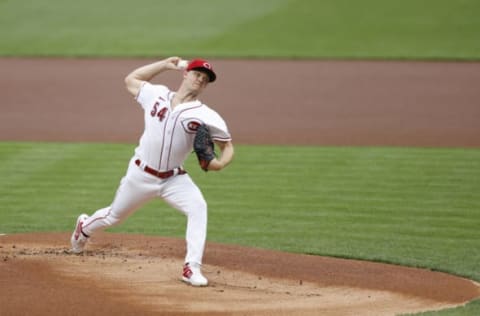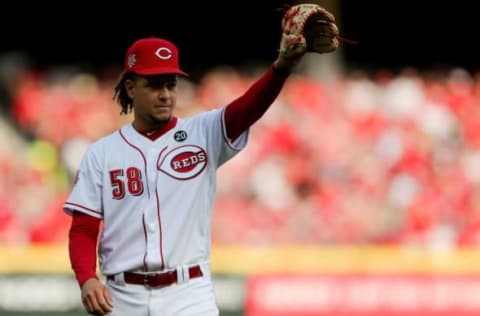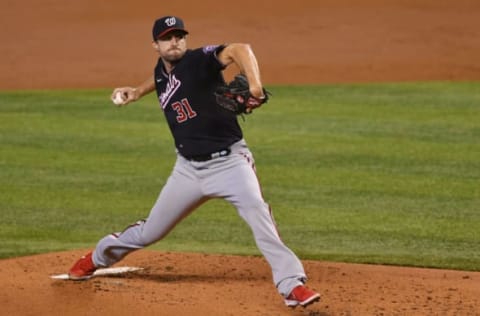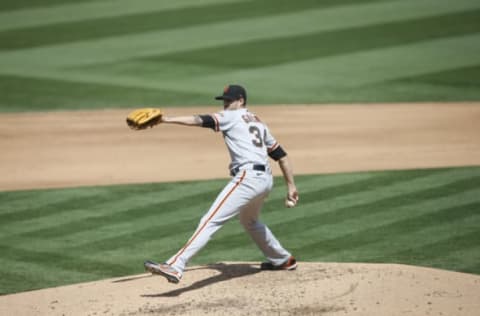Blue Jays: Part 2 – Examining potential pitching trade targets


To find part one in the series involving Blue Jays and potential pitching trade targets, click the link here.
As per the last article, all trades were conducted through the Baseball Trade Simulator in an attempt to find the best trades possible using both player ability and the player’s contract.
While the mentioned trades are just a small sample of what could be considered a trade scenario (and I highly recommend you try out the simulator for yourself because my suggestions are not the only scenarios), they attempt to satisfy the needs of both teams involved when looking at the opposite team’s depth charts and top prospects.
Toronto Blue Jays acquire: RHP Sonny Gray (29.7) (29.7)
Cincinnati Reds acquire: OF Lourdes Gurriel Jr. (26.3)
RHP Tom Hatch (2) (28.3)
or
3B Miguel Hiraldo (8)
RHP Alek Manoah (12.4)
RHP Trent Thornton (6.1) (27.0)
The one you have most likely been waiting for: Sonny Gray.
With Trevor Bauer joining the Los Angeles Dodgers via free agency, the Cincinnati Reds might have lost their ace but still have a solid rotation with the likes of Sonny Gray, Luis Castillo, and Tyler Mahle still on the roster. Based on a few projections from various sources/writers, the Reds look to be sitting around third or fourth in the NL Central division with the Milwaukee Brewers, Chicago Cubs, and St. Louis Cardinals making the battle pretty competitive this season (sorry Pittsburgh).
Overall, the Reds are sitting in a pretty comfortable spot considering they still have the likes of veterans Joey Votto, Mike Moustakas, Eugenio Suarez, and Nick Castellanos, as well as a strong farm system with pitchers Nick Lodolo and Hunter Greene inching closer to becoming major league ready.
That being said, it will be tough to pry Sonny Gray away from the Reds given that the team isn’t rebuilding but could be looking to upgrade the starting lineup if they feel like Lodolo could take over as a starter with the team being able to move Gray to save money.
Scenario 1
Similar to a few examples back in part one of the series, Lourdes Gurriel Jr. would be the main piece of this trade with pitcher Tom Hatch being added in to sweeten the deal.
A one for one deal involving Gray and Gurriel Jr. may not get the deal done, but adding Hatch could be enough to change the Reds front office minds to send the right-hander North of the border (or I guess to Dunedin as of right now). The Cuban outfielder could slot himself into the outfield alongside Castellanos, Shogo Akyiama, Nick Senzel, Arstides Aquino, and Jesse Winker as the Reds do have Eugenio Suarez at third base and prospect talent at shortstop (Jose Garcia) and third base (Jonathan India) with Moustakas manning second. There has been rumour that the organization has been looking to trade Suarez, which could help find a position for Gurriel Jr. if he were to join the organization.
Sonny Gray said the offseason trade rumors really frustrated him at times, but he doesn't hold any ill will toward the team. #Reds
— Bobby Nightengale (@nightengalejr) February 17, 2021
For Hatch, the Reds could use him in Gray’s spot in the rotation or in the bullpen, given the right hander has experience at both areas while Lodolo and Greene continue to develop.
On the Blue Jays side, Gray would slot in behind Hyun-Jin Ryu and there would be a pretty comfortable one-two punch at the top of the rotation. Hatch would have been around the fifth-starter spot but had some tough competition ahead of him with the recent additions of Steven Matz and Tyler Chatwood as well internal options like Jacob Waguespack, Trent Thornton, and Julian Merryweather. Scott Mitchell of TSN had Hatch being used as a starter to begin the season but down in AAA Buffalo.
Scenario 2
This trade differs from scenario one in that the Reds would be getting more prospect talent rather than MLB-ready players, with pitcher Alek Manoah being the biggest prize of the group.
Both Manoah (5) and Miguel Hiraldo (9) sit high on the Blue Jays top prospect list but both players as well as pitcher Trent Thornton could be expendable given the organization would:
- Acquire at least two years (club option for third) of veteran pitcher Sonny Gray
- Still carry rotation options like Nate Pearson, Tanner Roark, Robbie Ray, Anthony Kay, Tom Hatch, Steven Matz, Tyler Chatwood, Julien Merryweather, Jacob Waguespack, and Ross Stripling as options to round out the 3-5 spot in the rotation this year (with multiple players mentioned above being around for two+ years)
- Keep top prospects Jordan Groshans, Austin Martin, Alejandro Kirk, Orelvis Martinez, and Simeon Woods-Richardson in the organization
- Still have a mountain of infield prospects like Martinez, Groshans, Martin, Otto Lopez, and Leonardo Jimenez as well as a young core of infielders on the current roster in Vladimir Guerrero Jr., Bo Bichette, and Cavan Biggio
The main problem with this trade is that Manoah and Hiraldo could turn out to be legitimate everyday MLB players and Blue Jays management could kick themselves for trading away both players before they fully developed. While the risk is always present when trading away prospects, the opposite side of that argument is adding Sonny Gray helps the Blue Jays over the next two-three years rather than having to wait for both players to develop. Considering the Blue Jays look poised to be playoff contenders sooner rather than later, I feel like the risk might be one worth taking.
Sonny Gray upset by rumors, but happy not to be traded by Reds https://t.co/JrQHooqRMQ Sonny Gray very candid in how upset he was by multiple trade rumors, but grateful to still be a Red.
— Gary Miller (@Local12Gary) February 18, 2021
For the Reds, they would acquire two prospects who would slot into the top ten of their prospect charts as well as acquire a bottom of the rotation option in Thornton who still has four years of control. Once top prospects Lodolo, Greene, and newly acquired Manoah are MLB ready, Thronton can move to a long man position in the bullpen if need be or continue starting depending on how the rotation shapes up over the next two seasons. Hiraldo would continue to develop and could possibly be ready as early as next season but 2023 seems more likely.
Conclusion
While Blue Jays fans have been very adamant about seeking a trade to acquire Sonny Gray, there really has been no indication that the Reds are/were actively shopping the right hander this off-season. On top of trading for Gray, if Blue Jays fans are really keen on keeping Gurriel Jr., they would most likely have to supplement in a potential replacement in either catcher Alejandro Kirk or shortstop Orelvis Martinez. Acquiring a veteran pitcher with team control will cost the Blue Jays something significant in return, meaning fans might have to let some prospects go in return.
The one thing that could be a huge factor is the Reds are apparently looking to shed payroll given the financial hit teams took last year with COVID-19. The Reds traded closer Raisel Iglesias to get his salary off the books this off-season as well as non-tendering reliever Archie Bradley to save some money as well.
Look for a potential trade to pop up later this year around the trade deadline, as the Reds may be more open to a trade to save money but also because they could be out of playoff contention and looking to capitalize.
If the Blue Jays want to sweeten the deal and possibly save prospect capital, they could chose to absorb a larger contract like Moustakas or Castellanos alongside Gray to help the Reds alleviate salary concerns, but there would be a big financial risk as both players are owed significant money over the next three to four years (there are club and player options, but you get the idea) that the Blue Jays would have on their payroll.

Toronto Blue Jays acquire: RHP Luis Castillo (110.8) (110.8)
Cincinnati Reds acquire: UTIL Cavan Biggio (52.9)
C Alejandro Kirk (24.1)
SS Orelvis Martinez (22.2)
3B Kevin Smith (1.1) (100.3)
Another name high on Blue Jays fans lists, Luis Castillo is one pitcher that will require a lot of capital in order to get him North of the border.
In just four years in the MLB, Castillo owns a 3.62 ERA with 578 strikeouts,184 walks, and a 1.168 WHIP in 90 starts. The Dominican native is entering his prime years at 28 years old and has still three years of control, as he will be entering his second year of arbitration next year and will become eligible for free agency in 2024.
In this trade, the main centerpiece heading to the Reds would be utility player Cavan Biggio, a left-handed hitter capable of playing multiple positions in the infield and in the outfield. Accompanying Biggio would be three prospects on the Blue Jays top 30 list in catcher Alejandro Kirk (6), shortstop Orelvis Martinez (7), and SS/3B Kevin Smith (20).
For the Reds, Biggio could slot into almost anywhere in the infield as well as corner slots in the outfield. The organization could move one of their larger contract players like Mike Moustakas, Eugenio Suarez, or Nick Castellanos to make room for Biggio or chose to keep him as a utility player moving forward. Martinez and Smith would join the Reds farm system and continue working towards the MLB, while Kirk could slot in as the backup behind primary catcher Tucker Barnhart to begin the 2021 season. The Reds could also send Kirk to the minor leagues to continue developing and utilize Tyler Stephenson for the year, depending on when the trade occurs and how Kirk is playing this season.
For the Blue Jays, the rotation would have one of the best one-two punch combos in the American League with Hyun-Jin Ryu and Luis Castillo. Follow those two with a mix of Nate Pearson, Robbie Ray, and a fifth pitcher (there is a long list to choose from at the moment) and the Blue Jays have a very strong rotation to bolster them towards playoff baseball over the next few years.
Conclusion
This trade would hurt in terms of value leaving the organization, with the Blue Jays giving up two prospects they are very high on while also giving up a solid player in Cavan Biggio who will not be eligible for free agency until 2026.
This trade really would need some high-level prospects in order to get the deal done, and if you really don’t want to give up Biggio, then you would most likely have to substitute Jordan Groshans in his place. With the scenario above, the Blue Jays would still maintain their top five prospects while adding to the rotation without giving up a pitching prospect in return. You could probably do this trade without having to include Smith, but Baseball Trade Values would not accept the trade without the Smith addition (to push it over the 100 mark I guess).
This trade will most likely not happen anytime soon, as the Reds are not tanking nor rebuilding at the time and haven’t been actively shopping their current ace. This would mean the deal hinges mostly on Cincinnati wanting to shed payroll at the end of the year, as Castillo will command a bigger payday next year in arbitration.
The team has been fielding interest from multiple teams over the off-season, so it does appear that the Reds could move him at the right price. Hopefully, the price comes down when the trade deadline comes around, as adding Castillo to the rotation this season would be a huge bonus for a team fighting to play in October again.

Toronto Blue Jays acquire: Max Scherzer (5.2) (5.2)
Washington Nationals acquire: 1 or 2 of the following players:
RHP Adam Kloffenstein (4.5); SS Rikelvin de Castro (3.6); RHP C.J. Van Eyk (3.3); SS Leonardo Jimenez (2.9); SS Otto Lopez (2.6); RHP Tom Hatch (2.0), SS Kevin Smith (1.0)
One of the more veteran players to be included on the potential trade list, pitcher Max Scherzer on the Washington Nationals has been a dominant force in the MLB since his first all-star appearance and turning point in his career back in 2013. In 377 appearances (386 starts), the right-hander has a 3.21 ERA with 2784 strikeouts and a 1.100 WHIP over 13 seasons. Scherzer has had a fantastic career, winning three Cy-Young awards, appearing in seven all-star games, and winning a World Series championship back in 2019 with the Nationals organization.
The reason Max Scherzer could be traded this season is based on a few factors:
- If the Washington Nationals are out of playoff contention by the trade deadline
- The Nationals don’t believe they can/will re-sign him in the off-season when he becomes a free agent
- Scherzer’s desire to win another World Series if the Nationals are not in playoff contention
To make this trade happen, the Blue Jays would be able to use a few different combinations of players to get the deal done. They would most likely have to deal from their top 30 prospect pool to get Scherzer, but the deal wouldn’t nor shouldn’t require a top ten prospect given Scherzer only has one year left on his deal.
Now, this is where the deal becomes a lot more complicated.
With Scherzer spending the last six seasons with the Nationals, he qualifies for 10-5 rights, meaning he has a say in regards to being traded or not depending on the team in question and/or his desire to be traded. Scherzer has the power to nix trades and could also request things such as a contract extension with the team in question in order to agree to the trade. Essentially, if the right-hander doesn’t want to become a Blue Jay, the discussion ends there.
Now factor in that the Blue Jays also need to provide a trade package that the Nationals will need to accept against a host of other playoff-bound suitors, and the Scherzer deal will be challenging to facilitate. Not unachievable, but definitely a tough one to figure out for all parties involved.
In regards to the prospects/players involved, there are a few different combinations that can be used, but to be honest, it is difficult to narrow down an exact trade that could be offered to the Nationals.
The Blue Jays could chose to send a higher valued prospect like Kloffenstein similar to the Griffin Conine-Jonathan Villar / Kendall Williams and PTBNL-Ross Stripling deals done last season but could also chose to package a few lower-tiered (still above 20 ranked) prospects like Rikelvin de Castro and/or Leonardo Jiminez to try and hang on to players like Kloffenstein or Van Eyk. There are a few different ways to trade for Scherzer in this scenario, but any deal involving Miguel Hiraldo or higher should be a walking away point in my opinion.
Conclusion
While this deal is achievable, there is a lot of moving parts that need to align for the Blue Jays to land Scherzer later this year.
The Nationals will have to want to deal Scherzer and the pitcher will have to want to join the Blue Jays, which really isn’t known at this time if he is willing to be traded whether it be to the Jays or to any other team in the league. As of right now, there haven’t been any contract negotiations between the Nationals and their prize pitcher and Scherzer doesn’t appear ready to retire just yet.
The best bet for the Blue Jays is to be in a great position to win come July (obviously) so that if they do want to try and acquire Scherzer, they will be a team worthy of waiving his rights and can hopefully put together a package that entices the Nationals to let him go. The deal would most likely be for just one year (not a contract extension), meaning the Blue Jays would really be going for it by trading for Scherzer this season.

Toronto Blue Jays acquire: RHP Kevin Gausman (1.8) (1.8)
San Francisco Giants acquire: 1 of the following players:
SS Leonardo Jimenez (2.9); SS Otto Lopez (2.6); RHP Tom Hatch (2.0); SS Kevin Smith (1.0); RHP Jacob Waguespack (0.6)
Similar to the Scherzer trade mentioned last slide, a trade deadline deal for pitcher Kevin Gausman could be in the works if the chips all align come July.
A pitcher the Blue Jays were keen on from the beginning of free agency, starting pitcher Kevin Gausman was reportedly offered a three year contract by the Jays worth around $40 million. He would eventually sign the qualifying offer from the San Francisco Giants and will return there on the one-year deal. While the guaranteed money was there from the Blue Jays, Gausman appears to be betting on a successful 2021 campaign to try and garner a bigger payday during free agency next off-season when he won’t have the qualifying offer attached to his name. For his career, Gausman boasts a 4.26 ERA with 934 strikeouts and a 1.329 WHIP over 203 appearances (164 starts).
Compared to the other scenarios, Gausman isn’t one of the flashier options the Blue Jays could trade for this upcoming campaign. Coming off one of his better yet shortened statistical seasons, Gausman would be the veteran pitcher who adds more value to the Blue Jays rotation than the likes of some of the options towards the back end of the rotation. His role is to be a solid and dependable pitcher who won’t blow you away with 7-8 shutout innings but will keep the game close and give your bullpen a chance to keep the team in the game.
For the Giants, they would most likely be seeing a one for one deal similar to the trades the Blue Jays made last season for Jonathan Villar and Robbie Ray. In this scenario, there are a few different options who would/could be available in terms of trade value.
The Blue Jays could chose to trade a fringe starter like Tom Hatch or Jacob Waguespack who might not be on the active roster to begin the season but both could be used either as a starter or a reliever further along their careers. Alternatively, the Blue Jays could chose to trade an infield prospect like Otto Lopez or Leonardo Jimenez while still retaining other infield prospects Orelvis Martinez, Miguel Hiraldo, Estiven Machado, and Rikelvin de Castro. With the Blue Jays having an influx of infield talent, they could choose to take this route to acquire Gausman instead of dealing a fringe starter.
Conclusion
While he may not be the ‘big’ acquisiton compared to the likes of Sonny Gray or Max Scherzer, trading for Kevin Gausman could be a low risk trade that could provide another solid option in the rotation behind Hyun-Jin Ryu.
This trade only makes sense if:
- Kevin Gausman puts up numbers similar to last season or like in 2016
- If the Blue Jays do not sign Jake Odorizzi
- If Tanner Roark can pitch below a 4.00 ERA
Blue Jays: Examining potential starting pitching trade targets. dark. Next
If the Blue Jays do in fact sign Jake Odorizzi in spring training or Tanner Roark pitches like the $12 million player he was signed to be, then they won’t need Gausman as both pitchers kind of fill the similar role if they are playing well. There are obviously a few ‘ifs’ and ‘buts’ in this trade scenario, but if Gausman is pitching like he was in 2020 (over the whole season), then adding him to the rotation will be an addition that could provide the stability needed during the final stretch of the season if Odorizzi is pitching elsewhere and Roark is throwing meatballs down the plate.